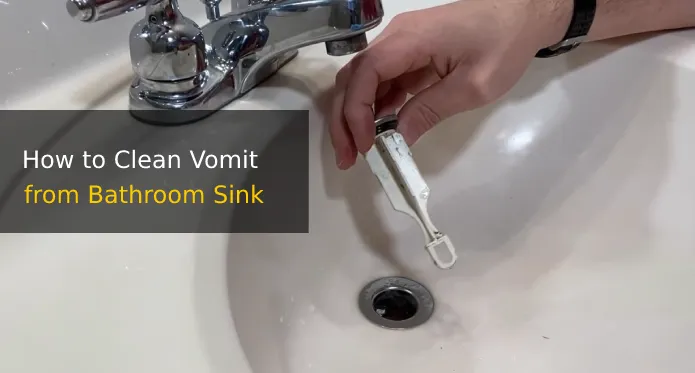Last Updated on July 31, 2023
When it comes to dreaded messes, vomit in the bathroom sink may top the list. But just because a surprise is waiting for you doesn’t mean all hope of a successful clean-up mission is lost.
To ensure your surfaces are sparkling and safe from vomit stains or corrosion, you must know how to clean vomit from bathroom sinks quickly and effectively.
There are several ways to tackle this messy situation, from boiling water to enzyme cleaners. Hydrogen peroxide also offers a reliable way to break down vomit and make it easier to clean up.
It’s important to know what methods are most suited for the job so that you don’t end up damaging your sink or spreading germs around your bathroom.
Here’s an overview of some of the most effective methods for cleaning vomit from the bathroom sink. By the end of this blog post, you should have all the information you need to successfully clean up any mess made by vomiting in the bathroom sink.
How to Clean Vomit from Bathroom Sink: DIY Methods
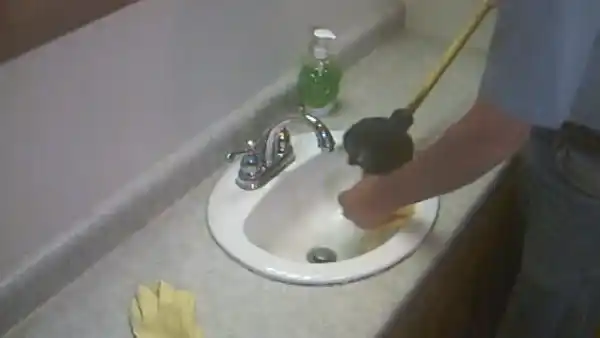
Whether the vomit is from a human or pet, cleaning up can be an unpleasant chore. Here are some easy tips on quickly and efficiently removing vomit from your bathroom sink.
Method 01: Boiling Water
You can clear blocked pipes, unclog drains, and reduce vomit clogs in bathrooms by boiling water. It is essential to exercise caution when using boiling water as it can cause severe burns or scalds if accidentally splashed on you.
When using this method to remove a vomit clog from a bathroom sink, heat up a pot or kettle of water until it reaches boiling point. Slowly and carefully pour the hot, boiling water into the affected sink drain.
Let the boiling water sit for about five minutes before draining it out, thereby flushing away any vomit in the way. This method will help loosen the vomit clog and remove it entirely from the sink.
Method 02: Baking Soda and White Vinegar
Another popular method of clearing vomit clogs in bathroom sinks is baking soda and white vinegar. To use this method, start by pouring one cup of baking soda down the sink drain, followed immediately by one cup of white vinegar. The resulting chemical reaction will produce foam which can help dissolve the vomit clog blocking your sink drain.
After pouring these two ingredients, let them sit for about 5 minutes before flushing them with hot water to help further loosen any remaining debris stuck in your plumbing system. Properly dispose of used materials, such as baking soda or vinegar.

Avoid disposing of these materials down storm drains or toilets, as this can cause further pollution and contamination problems within local waterways. Make sure not to mix baking soda and vinegar before use, as they react with each other very quickly, which could cause overflowing foam within your sink.
Method 03: Enzyme Cleaner
Another option for safely removing vomit from a bathroom sink is using an enzyme cleaner designed specifically for an organic matter like vomit. When using this type of product, it is essential to read and follow all package instructions carefully.
Generally speaking, enzyme cleaners work faster than traditional cleaners and are more effective in breaking down proteins found in food waste like vomit. But, these types of cleaners may pose some health risks due to their chemical composition and must be handled cautiously.
After allowing the product to sit overnight according to package instructions, flush away any residue with hot running water before properly disposing of hazardous waste. Here are some enzyme cleaners you can use to remove vomit from the bathroom sink:
Enzyme Drain Cleaner & Odor Eliminator: This enzyme-based solution is designed to quickly and effectively break down organic deposits blocking drains (like vomit) and eliminate odors. It’s non-toxic, so it won’t harm your pipes or the environment, yet powerful enough to unclog even the toughest clogs.
It uses a proprietary blend of enzymes that target grease, food particles, hair, soap scum, and other organic materials for fast results. The unique formula also helps to reduce odors created by these materials, restoring your sink or tub to its original freshness without harsh chemical smells.

Commercial Enzyme Drain Opener: This commercial-grade enzyme drain opener is explicitly formulated for tough clogs in commercial plumbing systems. It contains an advanced blend of enzymes that break down vomits, fats, oils, greases, and proteins found in restaurant kitchens and other commercial settings.
It works quickly and efficiently to clear clogged drains while leaving minimal residue. Regular use can help prevent future blockages by keeping organic material from building up in the pipes over time.
Non-Toxic Enzyme Formula to Eliminate Drain Odors: This non-toxic enzymatic formula utilizes naturally occurring bacteria to safely break down organic matter (like vomit), causing unpleasant odors in drains, sinks, and tubs.
Unlike traditional chemical cleaners that simply mask odors with fragrances as they pass through pipes and fixtures, this formula eliminates them by digesting the foul-smelling organic matter. The result is a cleaner smell around the drain area that lasts much longer than those resulting from chemical cleaners alone.
Method 04: Toilet Plunger
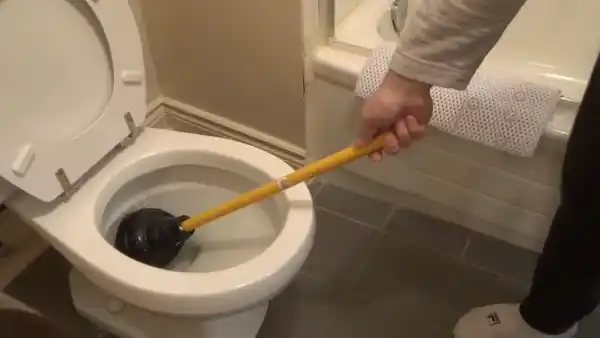
A fourth way to clear a clogged bathroom sink due to vomit is by using a toilet plunger. Start by placing the suction cup end of the plunger over the sink opening to form an airtight seal around it.
Next, begin pumping up and down several times until you hear or feel the suction breaking through whatever is causing the clog. Then remove the plunger once you successfully clear away whatever blockage was present before flushing hot water down the drain.
To get rid of any remaining residue after unclogging your sink, wipe off areas around where vomit had been with disinfectant wipes or a bleach solution if necessary. When finished, discard the used plunger according to local regulations to prevent cross-contamination.
Method 05: Plumbing Drain Snake
Using a plumbing snake is another easy way to clean vomit from a bathroom sink. Before using the snake, it’s essential to check your local hardware store, as they often have different sizes and lengths of snakes available for purchase.
When ready, insert one end of the snake into the sink opening until resistance is felt, and then turn the handle clockwise to apply pressure onto any blockage that may be present. This should help break up some of the debris and allow it to flow freely through your plumbing system again.
After you finish with the snake, make sure to discard it according to local regulations. If necessary, flush hot water down your drain and sanitize any affected areas with disinfectant wipes or bleach solution.
Method 06: Try an Auger
Augers can also be used for cleaning vomit from bathroom sinks. An auger is similar to a plumbing snake but has a longer cable which makes it easier to maneuver within pipes and access blockages or clogs more precisely.
Before using an auger in this scenario, it is important to remember to wear protective eyewear and gloves, just as with using a plumbing snake. Then insert the auger into the pipe, being mindful not to apply too much pressure on its handle so that you don’t cause further damage to your drain pipes in case of an unexpected blockage or clog.
Carefully move it around within your pipes until you can clear away any debris. Afterward, remove your auger from your bathroom sink’s pipes while discarding any debris inside a garbage bag-lined trash can per local regulations.
Finally, rinse your drain with hot water after use. If you want to be extra careful, clean it using disinfectant wipes or bleach solutions.
Does Hydrogen Peroxide Clean Vomit in Bathroom Sink?
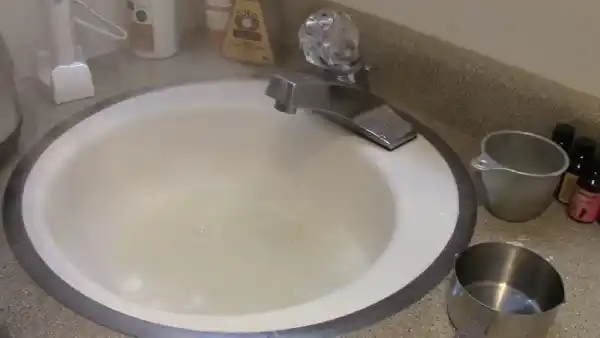
Hydrogen peroxide is an effective and affordable way to clean vomit from a bathroom sink. It is gentle enough for use on most surfaces to safely remove vomit without risking damage or discoloration.
To use hydrogen peroxide to clean vomit from a bathroom sink, pour one cup of hydrogen peroxide into the sink and let it sit for at least ten minutes before scrubbing the area with a sponge or cloth. If the clog was severe, you might need to repeat this process several times until the clog has been entirely removed.
Hydrogen peroxide is also effective in helping to break down any residue, such as food particles, that may have caused the clog in the first place. Also, it acts as a disinfectant, helping to prevent bacteria and germs from lingering in your bathroom sink after cleaning.
How to Clean Vomit Clogged Sink in a Bathroom without a Professional Plumber?
As mentioned above, cleaning a vomit-clogged sink in your bathroom without using professional plumbing services can be done using several methods.
One of the easiest ways is by pouring boiling water into the drain and some baking soda and white vinegar. This will help break up any residue causing blockage and flush out any remaining debris. Alternatively, you can try using an enzyme cleaner designed explicitly for clearing blocked drains; these cleaners are available at most hardware stores or online retailers.
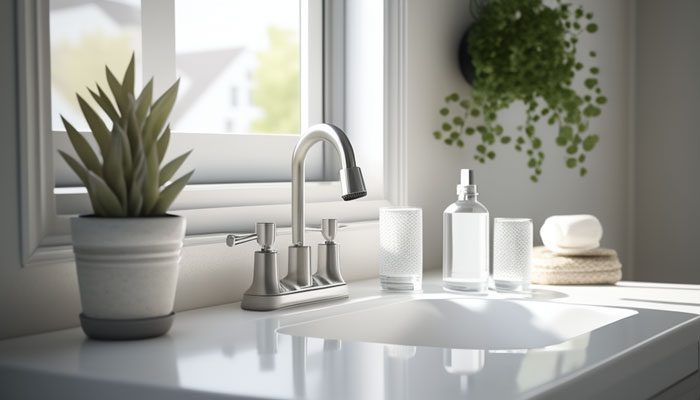
You can also try using a toilet plunger or plumbing drain snake if you think the blockage might be coming further down the pipeline. If all else fails, consider renting or purchasing a plumbing auger that can help clear more serious clogs that are deeper in your pipes.
Lastly, hydrogen peroxide can also be used effectively when dealing with clogs caused by vomit. Simply add one cup of hydrogen peroxide to your sink and allow it to sit for 10 minutes before scrubbing away any remaining debris.
Quickly and Easily Clean Vomit From Your Bathroom Sink
Cleaning vomit from a bathroom sink doesn’t have to be complicated or overwhelming. With the right materials and knowledge of the process outlined above, anyone can make their sink look like it never experienced any vomiting at all.
Prevention is critical to ensuring that your bathroom is safe from unwanted messes. Therefore, always remember not to leave food or beverages in the bathroom where someone may accidentally consume them without knowing better.
Keep up regular maintenance for your drains too, by regularly using baking soda and white vinegar for prevention and an enzyme cleaner for deep cleaning once every few months. By following these steps, you can be sure that your bathrooms remain free from any nasty surprises.

